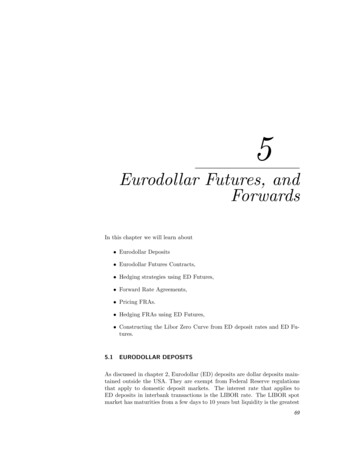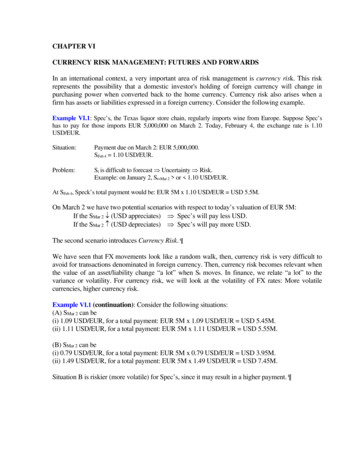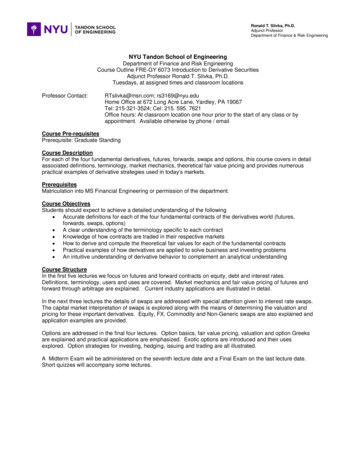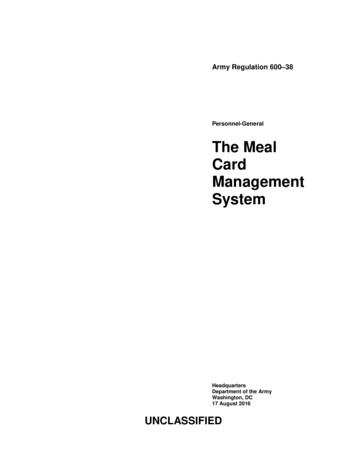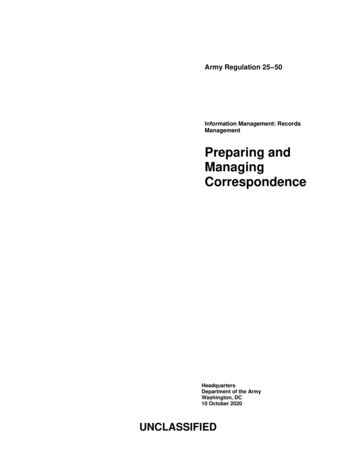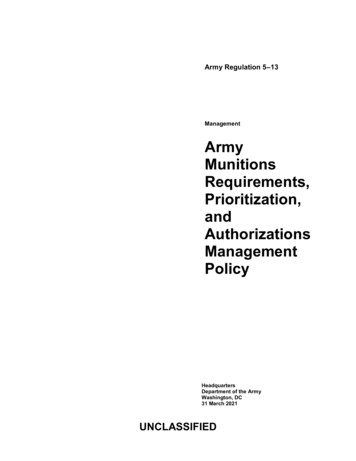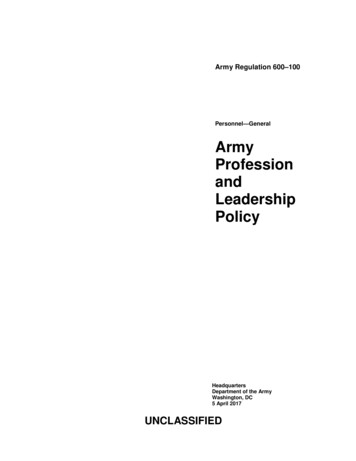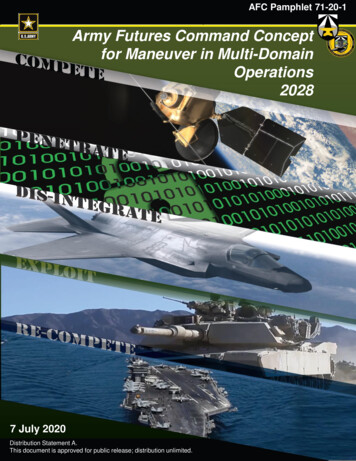
Transcription
AFC Pamphlet 71-20-1Army Futures Command Conceptfor Maneuver in Multi-DomainOperations20287 July 2020Distribution Statement A.This document is approved for public release; distribution unlimited.
This page intentionally left blank
AFC Pam 71-20-1ForewordFrom the DirectorU.S. Army Futures Command Futures and Concepts CenterIn 2018, TRADOC published TP 525-3-1, The U.S. Army in Multi-Domain Operations 2028(MDO), which is the Army concept to deter and, if necessary, defeat in combat adversaries withthe capacity and capability to challenge the United States to peer warfare in all domains and inevery element of warfare. Although the nature of war, its reasons and its objectives, remainunchanged through history, the conduct of 21st Century information age warfare is distinct from20th century mechanized warfare in many vitally important ways for which the U.S. military ingeneral, and the U.S. Army in particular, must change to address. One of the clearest distinctionsis the blurring of peace and war, a fact that MDO addresses by being the first Army OperatingConcept to include the full spectrum of conflict from peaceful competition through armed conflict.Although the distinction between the two at transition is blurred, large scale combat operations inan MDO environment are themselves distinct.The following concept, the Army Futures Command Concept for Maneuver in Multi-DomainOperations, 2028 describes how the Army will maneuver in large scale combat operations on theMDO battlefield. Although it addresses the role of maneuver in competition, this concept isfocused primarily on how the Army fights at echelon to win in combat against a peer competitor.While seemingly “offensive” in nature, the first prerequisite for deterrence is the unquestionedability to win in combat. This concept describes how the Army will array itself to overcomeadversary stand-off and defeat enemy combat formations in depth and in detail. The Maneuverconcept is nested firmly within MDO, yet also expands on MDO, accounting for two years ofglobal operational experience, and institutional study, wargaming and experimentation.Several key ideas underpin and enable this concept. Maneuver occurs simultaneously at everyechelon through division, corps and higher. Maneuver occurs in competition and during a returnto competition, not just armed conflict. In competition, we maneuver to gain position of advantage,shape security environments, support regional security, and enable rapid transition to armedconflict. In armed conflict, we maneuver to destroy or defeat enemy forces, control land areas andresources, and protect populations. The concept describes campaigns, the design of which mustinclude all domains at all echelons.A concept is the starting point for change, not its end. The 2018 publication of MDO initiateda series of studies, wargames, and experiments which have resulted in this maneuver concept anddescribes the conduct of a specific warfighting function at echelon.iii
AFC 71-20-1This concept must be followed by further effort within the Futures and Concept Center and thefunctional Centers of Excellence to determine how all the warfighting functions, not justmaneuver, integrate to succeed in the MDO fight at every echelon. Simultaneously, this conceptshould initiate exploration in the operating force to develop the tactics, techniques, and proceduresthat will operationalize MDO maneuver. It is the operating force and institutional Army workingtogether to achieve the precepts described in this concept that will ensure the US Army remainsthe most dominant land force in the world.ERIC J. WESLEYLieutenant General, U.S. ArmyDirector, Futures and ConceptsCenteriv
AFC Pam 71-20-1Figure 1. Maneuver in Multi-Domain Operationsv
AFC 71-20-1Figure 2. Logic Mapvi
AFC Pam 71-20-1Army Futures CommandFutures and Concepts CenterFort Eustis, VA 2360407 July 2020Force ManagementARMY FUTURES COMMAND CONCEPT FOR MANEUVER IN MULTI-DOMAINOPERATIONS, 2028FOR THE COMMANDER:OFFICIAL:ERIC J. WESLEYLieutenant General, U.S. ArmyDirector, Futures and ConceptsCenterJONATHAN PHILLIPSIT Resources Chief, G6History. This new Army Futures Command (AFC) document introduces the concept for how theArmy describes maneuver in 2028. This concept together with 71-20-2, Army Futures CommandConcept for Brigade Combat Team Cross-Domain Maneuver 2028 supersedes TRADOC Pam525-3-5, The U.S. Army Functional Concept for Movement and Maneuver dated February 2017.Summary. This concept describes how Army forces conduct maneuver within a dynamic andexpanded operational context that includes contested battlefields and domains, integratedadversary defenses with stand-off, operational and strategic deterrence challenges, andmultinational and governmental collaboration. Army forces confront highly lethal adversaries inan unpredictable operational environment, which combined with the new operational contextinforms the military problem to determine how Army forces achieve positions of relativeadvantage and generate overmatch. The central idea calculates success on simultaneous multiechelon convergence from all domains, and promotes enhanced joint and operational commandand control, echeloned maneuver, and decisive campaigns.Applicability. This concept applies to all Department of the Army (DA) activities that developdoctrine, organizations, training, materiel, leadership and education, personnel, facilities, andpolicy capabilities. This concept guides experimentation, force development, and supports theJoint Capabilities Integration and Development System process. It also supports Army capabilitiesdevelopment processes described in the Army Futures Command Concepts and CapabilitiesGuidance. When there are conflicts with other elements of the Army Concept Framework, thisdocument takes precedence.*This publication supersedes TRADOC Pam 525-3-6, The U.S. Army Functional Concept for Movement andManeuver, 2020-2040.Proponent and supplementation authority. The proponent of this pamphlet is the Director,1
AFC 71-20-1Directorate of Concepts (FCFC-CE), 950 Jefferson Avenue, Fort Eustis, VA 23604-5763.Suggested improvements. Users are invited to submit comments and suggested improvementsvia DA Form 2028 (Recommended Changes to Publications and Blank Forms) to Director, Futuresand Concept Center (FCFC-CE), 950 Jefferson Avenue, Fort Eustis, VA 23604-5763.Availability. This pamphlet is available on the FCC homepage at https://fcc.army.mil/resourcelibrary.Summary of change.AFC 71-20-1Army Futures Command Concept for Maneuver in Multi-Domain Operations, 2028This concept, dated 07 July 2020:o Expands upon the principles of maneuver, combined arms, operational warfare, and multidomain operations to operationalize the MDO concept.o Describes the requirement for multiple echelons to simultaneously converge lethal and nonlethaleffects to enable echeloned maneuver.o Recognizes the need to leverage operational Joint All Domain Command and Control (JADC2).o Recognizes the need for an adversary focused operational-level echelon to compete with,immediately contest, and defeat peer adversaries.o Expands upon the concept of maneuver during armed conflict to defeat the adversary’s militarysystem.o Describes maneuver by Army forces from strategic and operational distances, the conduct ofecheloned maneuver to enable joint force operations, and defeat adversary maneuver forces.o Defines maneuver as the employment of forces through movement in combination with lethaland nonlethal effects across multiple domains, the electromagnetic spectrum, and the informationenvironment to destroy or defeat adversary forces, control land areas and resources, and protectpopulations.2
AFC Pam 71-20-1Table of ContentsChapter 1 Introduction .51-1. Purpose .51-2. References .61-3 Explanation of abbreviations and terms .61-4. Background .61-5. Assumptions .81-6. Linkage to Army and joint concepts .91-7. Conclusion.10Chapter 2 Operational Context .102-1. Introduction .102-2. Military technologies .112-3. Technology applied to global power .122-4. Emerging operational environment .132-5. Contested domains and environments .132-6. Vulnerabilities and weaknesses .162-7. Implications of the operational environment .17Chapter 3 Military Problem and Components of the Solution .183-1. Military problem .183-2. Central idea .183-3. Solution synopsis .183-4. Application of maneuver to multi-domain operations .253-5. Components of the solution.283-6. Conclusion.31Chapter 4 Maneuver in Multi-Domain Operations and Campaigns .324-1. Introduction .324-2. Army multi-domain operations at echelon .324-3. Maneuver at echelon during competition .334-4. Maneuver at echelon during transition to combat operations. .374-5. Maneuver at echelon during large-scale combat operations .404-6. Maneuver at echelon during de-escalation and transition to return to competition .47Chapter 5 Conclusion .50Appendix A References .51Appendix B Required Capabilities .56B-1. Introduction .56B-2. MMDO RCs .57Appendix C Science and Technology .59C-1. Introduction .59C-2. Emissions control and signature management.59C-3. Maneuver at echelons .62C-4. Enabling technology for decision making .65C-5. Conclusion .67Appendix D Dependencies .68D-1. Introduction .68D-2. Dependencies derived from the MMDO concept (under development) .683
AFC 71-20-1Appendix E Space and Cyberspace Scope Maneuver .68E-1. Introduction.68E-2. Example space and cyberspace tasks in scope for the MMDO concept .69E-3. Example of space and cyberspace descriptions out of scope .69Glossary .70Section I Abbreviations .70Section II Terms .72Section III Special Terms .82NOTE: Appendix D is under development. This appendix will be completed post-publicationas an addendum4
AFC Pam 71-20-1Chapter 1Introduction1-1. Purposea. The Army Futures Command Concept for Maneuver in Multi-Domain Operations 2028(AFC 71-20-1) describes how, in the future operational environment (OE), Army formations willconduct maneuver to defeat peer adversaries and regional competitors. When combined with theBattlefield Development Plan 2019: Field Army, Corps, and Division in Multi-Domain Operations2028, the AFC 71-20-1 advances the ideas found in TRADOC Pamphlet (TP) 525-3-1, The U.S.Army in Multi-Domain Operations 2028 (MDO concept). These ideas inform the defense industryand scientific community with a future vision to guide near-, mid-, and far- term core technologyand advanced capability development efforts needed to build a multi-domain operations (MDO)capable force. Experimentation, testing, and wargaming has validated and reinforced therequirements outlined in the MDO concept. The Battlefield Development Plan (BDP) hasexpanded and codified this understanding.b. AFC 71-20-1 builds upon almost two years of study, wargaming, and experimentation sinceMDO was published. This concept remains nested within MDO and reflects refined understandingof the problem and the application of MDO’s central idea. Therefore, where AFC 71-20-1, theMDO concept, and existing functional or supporting concepts conflict, the ideas described in the71-20-1 takes precedence. As a concept, this document extends beyond historical and currentdoctrine by describing new ways of conducting future campaigns through multi-domain maneuver.AFC 71-20-1 provides the ideas for advancing maneuver at all levels of war across the competitioncontinuum, incorporating effects from all domains and environments, and depicts how the MDOforce is arrayed in time and space.c. AFC 71-20-1 poses the following questions to guide its development:(1) What will be the Army’s contribution to joint maneuver?(2) How will maneuver contribute to the execution of the Army's four strategic roles?1(3) How will Army forces conduct maneuver in support of competition?(4) How will Army formations gain and maintain the initiative in competition and withintheir assigned area of operations (AO)?2(5) How will future Army formations visualize the entirety of their battlefield in all domains,the electromagnetic spectrum (EMS), and the information environment (IE) to identify decisivespaces and synchronize echeloned maneuver to maintain relative advantage while maneuvering?(6) How will the Army conduct echeloned maneuver during future large scale combatoperations?(7) How will future Army formations maneuver during periods of degraded command and5
AFC 71-20-1control (C2)?(8) What enables future Army formations and provides the ability to consolidate gainscontinuously and endure for the duration of future campaigns against a peer adversary?(9) How will future Army formations converge effects across multiple domains andenvironments to gain positions of advantage relative to the adversary, the terrain, and thepopulation?(10) How will the Army array and employ future Army formations to conduct multi-domainoperations and prevail in large-scale combat against highly capable peer adversaries and regionalcompetitors?d. This concept proffers how Army forces maneuver to gain positions of advantage incompetition and conflict. As part of a joint and multinational force, Army forces will maneuverat echelon to deter adversaries and regional competitors during competition, dominate and win inarmed conflict, and return to competition on favorable terms. During competition, Army forceswill support regional engagement, shape the security environment, prevent conflict, and provideoptions for responding to and resolving crisis. When necessary, Army forces transition rapidly toarmed conflict, continuously converging lethal and nonlethal effects, and maneuver to destroy ordefeat adversary forces, control land areas and resources, and protect populations.1-2. ReferencesAppendix A lists required and related publications.1-3. Explanation of abbreviations and termsThe glossary explains abbreviations and special terms used in this pamphlet.1-4. Backgrounda. During the Global War on Terror the U.S. Army transitioned to a brigade combat team (BCT)centric mode of operations. This enabled the predictable rotation of combat power to Iraq andAfghanistan over secure, uncontested lines of communications (LOCs). The Army was able toadopt this BCT-centric mode of operations because of the nature of the adversaries in Iraq andAfghanistan. The Army was never threatened with tactical or operational defeat above the platoonlevel.b. With the reemergence of Russia and China as adversaries this is no longer the case. Russiaand China employ formations and capabilities (lethal and nonlethal) that overmatch those of theU.S. in range and lethality, thus challenging the Army’s ability to conduct operational maneuver,gain positions of relative advantage, and generate close combat overmatch. These capabilities area prerequisite for the Army to achieve the objectives that support the return to non-crisiscompetition on favorable terms. Unless the Army adapts to the new realities of the modernbattlefield, the joint force could face tactical and operational defeat. Such a defeat could havestrategic consequences such as loss of the cohesion of alliances or escalation to nuclear conflict.6
AFC Pam 71-20-1c. These challenges demand a return of operational-level warfighting to ensure the Army isable to support joint force objectives in competition and, if necessary, in conflict. Against a peeradversary, the Army will require four echelons to conduct maneuver in multi-domain operations:theater army, an operational-level headquarters, corps, and division.3 All of these echelons willbe in contact simultaneously and must synchronize their fights across echelons as they engage ina continuous cycle of penetration, dis-integration, and exploitation conducted throughout the depthand breadth of the battlefield. Each of these echelons will concentrate warfighting functions on adesignated aspect of the fight, freeing the others to concentrate on their portion. The result of thisconcentration will be the defeat of the adversary’s layered stand-off (antiaccess (A2) and areadenial (AD)) methodology allowing Army forces to maneuver from operational distances andbringing the full power of the joint force to bear on the adversary. To maximize the potential ofthe operational-level echelon’s ability to converge multiple domains simultaneously, the Armydivision remains both the lowest echelon capable of multi-domain operations and the foundationalmaneuver echelon.5d. With MDO, the Army is transitioning back from BCT to division centric maneuver. It is theArmy division that will create tactical overmatch and defeat peer adversaries in the close fight byconverging aviation, fires, electromagnetic warfare, and protection assets, to support the maneuverof its BDEs to the direct fire fight. However, the division will not succeed in close combat unlessthe corps and an operational-level headquarters set the conditions for divisional maneuver prior to,and during, armed conflict. In addition to allocating resources to help its subordinates succeed inthe close fight, the corps will converge Army long range precision fires (LRPF), aviation, andcyber-electromagnetic activities (CEMA), to defeat the adversary’s mid-range systems andenabling its subordinate divisions to prevail in the close fight.e. An operational-level headquarters will maneuver multiple corps, at least one of which willlikely be multinational. The operational-level headquarters converges national capabilities,CEMA, space capabilities, special operations forces (SOF), aviation, and LRPF to penetrate anddis-integrate the adversary’s long-range fires and its integrated air defense system (IADS). Theseactions enable the operational-level headquarters to maneuver from operational distances to bringits subordinate echelons to the fight with the ability to achieve overmatch against the adversary’sforces. The theater army integrates space and information capabilities throughout the theater ofoperations in support of the operational-level headquarters and the joint force. A host of sensorsacross the depth of the battlefield and within range of adversary indirect fire require thatcamouflage, concealment, and deception—conducted in all domains—become an integral part ofoperations at every echelon.f. All of this will take place in the course of campaigns, not battles. For while it is natural todesire to win in as short of a conflict as possible, peer adversaries have resilient military systemsand the Joint force must plan for campaigns. The operational-level headquarters will develop thesecampaign plans and supervise their execution in both competition and conflict ensuring theadversary is kept off balance and allowing U.S. forces to maintain the initiative. This makes thetheater army’s requirement of setting the theater and calibrating effective force posture especiallyimportant.7
AFC 71-20-11-5. Assumptionsa. The assumptions from the MDO concept, Battlefield Development Plan 2019, and the BDPapply to this concept.b. The following assumptions also apply:(1) The division will be the Army’s primary combined arms, close combat, tactical fightingformation capable of executing limited multi-domain operations. When employed, it will be ableto operate as an independent, task-organized, multi-domain formation.(2) In large-scale combat operations against a peer adversary, the corps and division willoperate primarily at the tactical level, conducting MDO or cross-domain maneuver as necessaryto ensure success. Brigades (BDEs) will conduct cross-domain maneuver.(3) In geographic combatant commands (GCCs) without a dedicated operational-levelwarfighting headquarters, the theater army can perform that role for a limited period of time againstregional competitors with augmentation. However, this additional role may significantly impacttheir execution of Army service component command responsibilities to support the combatantcommander.(4) The Joint force and Army formations will need to continuously converge lethal andnonlethal effects across multiple domains, the EMS, and IE to enable units to conduct echelonedmaneuver. Echeloned maneuver is Army air-ground movement in depth supported by ground firesalong with air, maritime, space and cyberspace generated effects to gain positions of advantage,penetrate adversary defenses, and conduct exploitation. Echeloned maneuver provides agility,resilience, and flexibility to the force and enables independent maneuver of distributed formationsor units to seize the initiative, achieve momentum, and control tempo, thus protecting the force.Echeloned maneuver overcomes the difficulty of massing at the point of successful penetrationenabling higher echelons to converge Army maneuver forces rapidly with effects from otherdomains across an expanded battlefield. Echeloned maneuver enables operational-levelcommanders to seize terrain, control populations, and destroy or defeat adversary forcesthroughout the depth of their area of operations.(5) Adversary forces will limit friendly freedom of action across the competition continuum.Adversarial forces will contest and attempt to disrupt Army communications, observation, sensing,precision fires, and position, navigation, and timing (PNT), and selectively deny domains andenvironments.(6) The joint force and national assets will need to converge lethal and nonlethal effectscontinuously across multiple domains, the EMS, and IE to enable Army forces to maneuver.(7) Army forces will adapt to account for the changing OE in both competition and conflict.8
AFC Pam 71-20-11-6. Linkage to Army and joint conceptsa. AFC 71-20-1 is nested and linked conceptually with the MDO concept and BattlefieldDevelopment Plan 2019. This body of work serves as a baseline for developing other Armyfunctional, supporting, and operational and organizational concepts, by describing how thosefunctions, formations, and capabilities will be employed in MDO. While AFC 71-20-1 does notre-invent or occupy the same conceptual space as the MDO concept, it does move the Army'sunderstanding of MDO forward. This concept remains nested within MDO, reflects a betterunderstanding of the problem, and the application of the MDO central idea. The ideas described inAFC 71-20-1 takes precedence in the event there is conflict between ideas or concepts describedwithin the MDO concept or other Army Concept Framework documents. (See figure 1-1 for theArmy Concept Framework.) The MDO and AFC 71-20-1 concepts support the National DefenseStrategy and National Military Strategy by describing, in part, how the Army will executeoperations to fulfill the Army’s four strategic roles. Further, the MMDO concept uses contact,blunt, and surge forces concepts found in the National Defense Strategy.4Figure 1-1. The Army Concept Framework (abridged)b. Like the MDO concept, the AFC 71-20-1 nests within the Joint Concept for IntegratedCampaigning (JCIC) competition continuum construct. Leveraging the backdrop of the JCICcompetition continuum, AFC 71-20-1 proposes a multi-domain, operational-level approach tomaneuver that describes how Army forces contribute to deterring and, if necessary, defeating peeradversaries. The Battlefield Development Plan 2019 operationalizes the MDO concept at theoperational and tactical levels for division and higher echelons, describing the need forindependent, echeloned, multi-domain warfighting formations. AFC 71-20-1 adds greater detailto the Army’s understanding of MDO, proposing the notion of echeloned maneuver as the nestedapplication of MDO. These documents provide the foundation and underlying operational logicnecessary to develop the required capabilities to achieve an Army capable of executing MDO.9
AFC 71-20-11-7. Conclusiona. AFC 71-20-1 describes how Army formations conduct maneuver to deter adversaries anddefeat or destroy adversary forces in 2028. AFC 71-20-1 proposes concepts and capabilitiesnecessary to provide commanders with multiple options to seize and control terrain, defeat ordestroy adversary forces, protect populations, activities, and infrastructure to achieve missionobjectives. This concept operationalizes the MDO concept, proposing echeloned maneuver as theapplication of MDO and espouses the rapid and continuous integration of multi-domain, EMS,and IE capabilities to deter and, if necessary, prevail during competition short of armed conflict.If deterrence fails, Army formations converge joint, interorganizational, and multinational (JIM)capabilities to open decisive spaces enabling the joint force to conduct echeloned maneuver topenetrate and dis- integrate adversary A2/AD systems. Further, Army forces exploit the resultingfreedom of maneuver to defeat adversary systems and formations, while consolidating gains, toforce a return to competition on terms more favorable to the U.S., its Allies, and partners.b. AFC 71-20-1 describes how future Army formations incorporate effects continuously fromall domains and environments to conduct maneuver at all levels of war and throughout thecompetition continuum to defeat peer adversaries and regional competitors. Chapter 2 describesthose aspects of the future operational environment (OE) from 2028 and beyond that are relevantto conducting maneuver by future Army of echelons at division- level and above. Chapter 3provides the theoretical basis for maneuver by future Army formati
every element of warfare. Although the nature of war, its reasons and its objectives, remain unchanged through history, the stconduct of 21 Century information age warfare is distinct from 20th century mechanized warfare in many vitally important ways for which the U.S. military in general,


